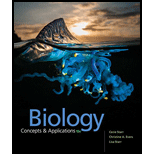
The first plants were_________.
| a. ferns | c. |
| b. flowering plants | d. conifers |
Introduction:
Plants are eukaryotic, multicellular and photosynthetic organism on Earth. The plants evolved 450 million years ago from a group of freshwater alga. These contain chlorophyll, which helps in the process of photosynthesis.
Answer to Problem 1SA
Correct answer:
The first plants were bryophytes. Hence, the correct answer is option c.
Explanation of Solution
Reason for correct answer:
Option c. is given as, “bryophytes.”
Bryophytes are called first plants because they are capable of surviving in water as well as on land. They are commonly known as nonvascular plants. Bryophytes are categorized into three lineages: liverworts, mosses, and hornworts. They have internal conducting vessels. They obtain nutrients from the surface. They have a better capability to survive in unfavorable conditions such as drought. The vascular plants such as ferns and conifers have evolved from bryophytes.
Reason for incorrect answer:
Option a. is given as, “ferns.”
Ferns are called seedless vascular plants. They release spores into the environment that develop into a gametophyte. Ferns have fronds (leaves) and a horizontal underground stem. Hence, option a. is incorrect.
Option b. is given as, “flowering plants.”
Angiosperms are called flowering plants because these are the only plants that can make flowers and fruits. These have leaves, sepals, and petals. These are considered as the most evolved group of plants. Hence, option b. is incorrect.
Option d. is given as, “conifers.”
Conifers are included in the class of gymnosperms. These include various species of shrubs and trees. These can tolerate drought conditions as well as cold conditions. Conifers generally have naked seeds. Hence, option d. is incorrect.
Hence, the options a., b., and d. are incorrect.
Bryophytes were characterized by vessels and flagellated sperms. They do not have seeds, leaves, and stem. It is the reason bryophytes are considered as first plants. Thus, the correct option is c.
Want to see more full solutions like this?
Chapter 21 Solutions
Biology: Concepts and Applications (MindTap Course List)
- 86 ________ are seedless vascular plants. A. Angiosperms B. Ferns C. Gymnosperms D. Bryophytesarrow_forwardBoth early plants such as mosses and ferns required water:  A. To reproduce via flagellated sperm. B. Due to a lack of waxy cuticle C. To transport nutrients D. Due to a lack of cell wallarrow_forwardA botanist travels to an area that has experienced a long, severe drought. While examining the bryophytes in the area, he notices that many are in the same life-cycle stage. Which life-cycle stage should be the most common? a. zygote b. gametophyte c. sporophyte d. archegoniumarrow_forward
- Which of the following was a challenge to the survival of the first land plants? Select one or more: O a. Desiccation (drying out) O b. Transportation of water between tissues O c. Shortage of carbon dioxide d. Animal predation O e. Too much sunlight (UV-radiation)arrow_forwardHorsetails often grow well in soil that hosts other plant species. Which factor should be analyzed to determine the ecological relationship between the horsetail and other species in its community? A. whether the horsetail evolved from other plants B. whether the horsetail harms other plants C. whether the horsetail produces flowers D. whether the horsetail produces sporesarrow_forwardThe production of megaphylls by many different species of plants is an example of _____. a. parallel evolution b. analogy c. divergent evolution d. homologyarrow_forward
- Lignin supports the stems of_______ . a. mosses c. ferns b. hornworts d. liverwortsarrow_forwardThe simplest group of modern land plants listed below is A. gymnosperms B. angiosperms C. cycads D. fernsarrow_forward1. The term specie is a singular form of species? A. True B. False 2. Phenology is a specialized branch of botany that deals with the life cycle of plants? A. True B. False 3. If a student plants or studies cell division, the student has the ability to witness a plant characteristic known as: A. Assimilation B. Sexual Reproduction C. Growth D. Metabolismarrow_forward
- According to the cladogram, which organisms do not have vascular tissue? A. Ferns O B. Gymnosperms C. Mosses O D. Angiospermsarrow_forwardPlants develop from stem cells called O A. blastocyst B. meristems C. embryonic stem cells D. adult stem cellsarrow_forwardPrimary meristems produce tissues that A) increase the length of a plant B) produce the cork cambium C) increase the width of a plant D) lead to the production of bark E) increase the mass of a plantarrow_forward

 Concepts of BiologyBiologyISBN:9781938168116Author:Samantha Fowler, Rebecca Roush, James WisePublisher:OpenStax College
Concepts of BiologyBiologyISBN:9781938168116Author:Samantha Fowler, Rebecca Roush, James WisePublisher:OpenStax College Biology (MindTap Course List)BiologyISBN:9781337392938Author:Eldra Solomon, Charles Martin, Diana W. Martin, Linda R. BergPublisher:Cengage Learning
Biology (MindTap Course List)BiologyISBN:9781337392938Author:Eldra Solomon, Charles Martin, Diana W. Martin, Linda R. BergPublisher:Cengage Learning


